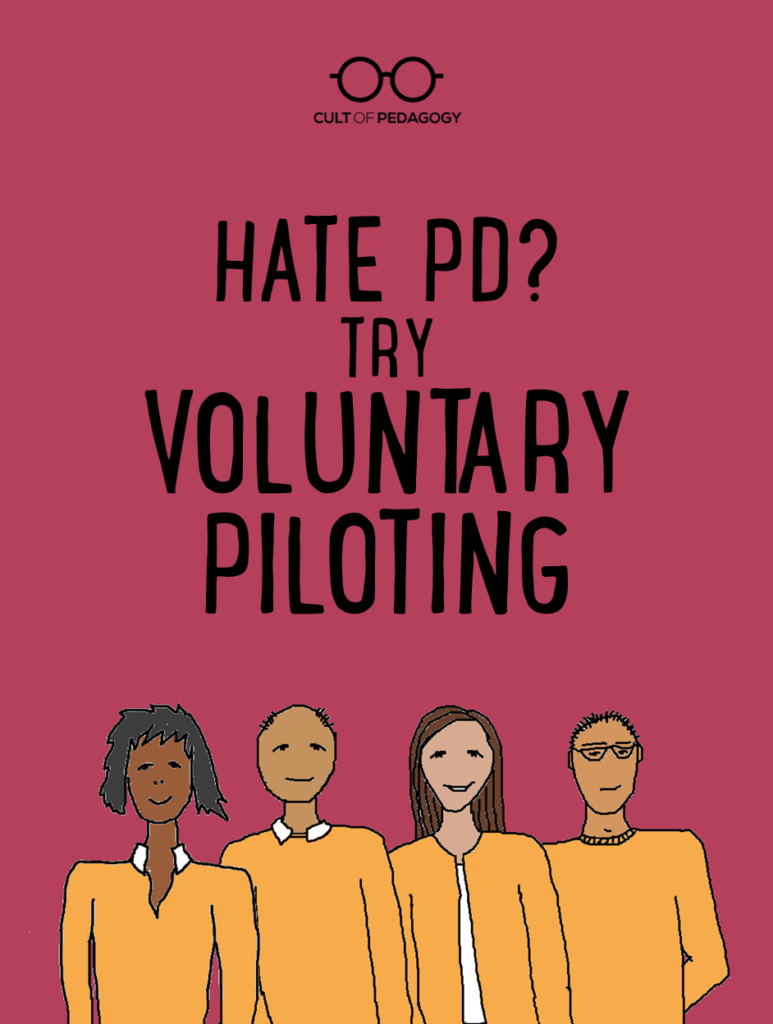
Guest post by Krista Taylor. An earlier version of the post originally appeared on Angels and Superheroes.
Teacher professional development has a reputation for being notoriously poor.
So often it’s a top-down approach that’s out of touch with the challenges of being in a classroom. But what if teachers took control of that and turned it on its head? What if teachers determined how they needed to grow and develop, and worked together to do so?
In 2013, my colleague, Josh, and I began discussing some of the concerns we had about our instruction. Both of us had prioritized developing differentiation practices in our classrooms. Both of us were frustrated with our perceived lack of progress. We began trying to figure out how we could make the work easier and find greater success.
In our urban public school where 70% of students are eligible for free lunch, our students often come to us with below-grade level skills, poorly developed work habits, and a lack of academic buy-in. All too often, this combination of high expectations and low skills results in students with failing grades. How do we maintain high academic rigor while also meeting students (especially our most challenged ones) where they are? Is this not the crux of the conflict in most classrooms?
Although I teach 7th and 8th graders and Josh teaches 11th and 12th graders, we realized we had both been working independently on finding solutions to this same struggle, and we guessed there might be more of us. We had been unable to do this individually, but we thought we might be able to do it better with the support of each other and any other colleagues who might be interested in joining us.
We approached Jack (our principal) with the idea of launching a voluntary differentiation pilot program in our building, and after hashing out some of the details, we were given permission to broach this topic with our faculty and elicit support from the staff of our regional Montessori teacher education program.
We began by issuing this open invitation.

Additionally, we personally invited those who we felt would be most receptive. Some people asked if they could earn CEUs (Continuing Education Units) for their participation. We took this request back to Jack who readily agreed to arrange this. A few other details were hashed out—how we would re-initiate the conversation in the fall, when we would schedule the first meeting, and what that agenda would look like.
Thus, from what started as a casual discussion, a pilot project was born.
So, that’s it, right? Open the door to collaboration, the masses will come running, definitive answers will be found, and all will be well with the world.
Well, no, not exactly.
The Program Begins
Our group of volunteers met at the start of the year to establish what we wanted to accomplish together. Originally there were ten of us, but after this first meeting, we were reduced to just seven through self-selection.
Initially this small number of participants felt very disappointing—where were the hordes of teachers flocking together to improve their practice? That was definitely what I had envisioned. However, in hindsight, I’m convinced our small size was one of the most critical components of our success. Joining our pilot was purely voluntary, and this ensured that only people willing to commit to doing this work in a positive and forward-thinking way joined our group. Those who didn’t share our vision opted out. This meant that while we didn’t have the numbers I had anticipated, we also didn’t have the uncommitted, disengaged participants I’d worried about.
A large body of evidence suggests that the way to shift institutional practices is to begin with the people who have immediate buy-in. From their success, you will sway most others. This premise is known as the Diffusion of Innovations Model and was introduced by Everett Rogers in 1962. After initiation by the “innovators,” the concept readily spreads to “early adopters” who ultimately influence the “early majority.” It is not necessary to address resistors, or the “late majority and laggards,” until there is a groundswell of people on board who can carry them along.
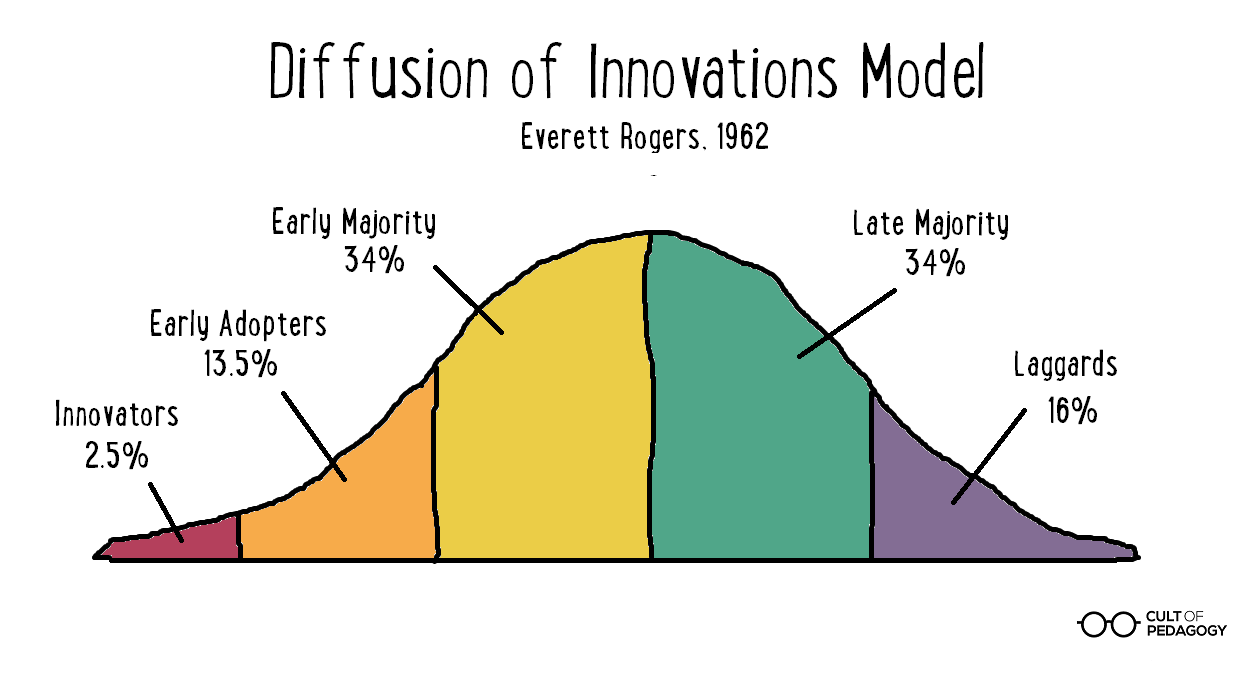
Because our group was made up of our innovators and early adopters, we were free to develop into whatever we believed would work for us. Although we were all teachers in the same building, we didn’t all work closely with one another on a regular basis. As a result, it was important to develop clear expectations for our work together. The parameters we established at our initial meeting were:
- We would meet once a month.
- We would honor each other’s time by keeping meetings as close to an hour in length as possible.
- We would value our time together by committing to attend meetings.
- Our focus would be on classroom differentiation as a means of growing all learners.
- We would conduct focused, non-evaluative observations of each other to improve our practice—we called these “Friendly Feedback Observations.”
We quickly discovered that we were already doing a lot. Just stating differentiation as an intention at our initial meeting in September had motivated each of us to work toward furthering our practice in this area. But we had our share of noteworthy challenges too, and we still had a long way to go to develop what we wanted to see in our classrooms.
Our challenges clustered into four areas of differentiation: assessments, assignments, instruction, and expectations. By looking at it this way, we quickly realized we were putting the cart before the horse by starting with the products (the assessments and assignments) rather than the students (the expectations).
Through our conversations, we also recognized that we were all feeling uncomfortable with meeting students where they were and moving them forward along a continuum, even if that meant they didn’t ultimately reach the grade-level outcome. For all our nose-thumbing, anti-testing bravado, we felt pretty nervous about championing the idea that not all students learn the same thing at the same time and reach the same place, and somewhat blindly trusting that this wouldn’t have terrible repercussions on our standardized test scores.
It was critical to have each other to bounce ideas off of and to ensure that we were maintaining appropriate expectations coupled with appropriate supports for all of our students. Together we were able to achieve what none of us had been able to do alone. We noted gains—even incremental ones, we dug deep into what best practice could look like, and collectively, we had more courage to take risks.
And while each month we celebrated our successes, we also took a hard look at our challenges.
Bumps in the Road
Halfway through that first year, we remained dissatisfied by the number of students earning failing grades. How could this be? We had worked so hard! How could all of our efforts still have not been enough to support students? How were our students still falling short of our expectations? What were appropriate expectations? How would we know when we reached them?
Fortunately, Barb Scholtz, the practicum director from our Montessori teacher ed program, was supporting and challenging us in our reflective practice. When this concern came up, she simply looked at us, and with this simple question, re-committed us to our mission. She asked, “Well, are they learning?” When we answered with a confident “Yes,” her response was, “Then how can they be failing?”
It sounds simple, right? If they are learning, if they are progressing, then that’s all we can ask of them, right? But what about standards-based grading? What about content mastery? What about pre-requisite skills?
Nothing in education is simple. We know about Vygotsky’s Zone of Proximal Development, which notes that learning occurs just beyond the level of what students can do independently. We know about isolating the difficulty, or focusing on a new skill without adding in additional complexities. And, perhaps most importantly, we know our students. We know as professionals, and as people who interact with them every day, what we can expect from them and how far we can push them. So yes, if they are learning, they can’t possibly be failing. But too many of them were. What were we doing wrong?
So back to the drawing board we went to try to find answers. We turned to research to guide us. We looked at best practices in grading policies, strategies to improve rates of homework completion, and use of student self-evaluation tools.
We also invited one another into our classrooms for what we deemed “Friendly Feedback Observations.” We asked each other, as trusted professionals, to observe specific concerns in our practice and to provide both critical and supportive feedback. This not only elicited targeted suggestions for improvement, it also allowed us to see what we were each doing really well, and what techniques we could borrow to improve our own instruction.
We adjusted and enhanced our teaching practices again and again. Each of us did that a little differently. Each of us discovered inroads. None of us got it exactly right. But all of us made progress.
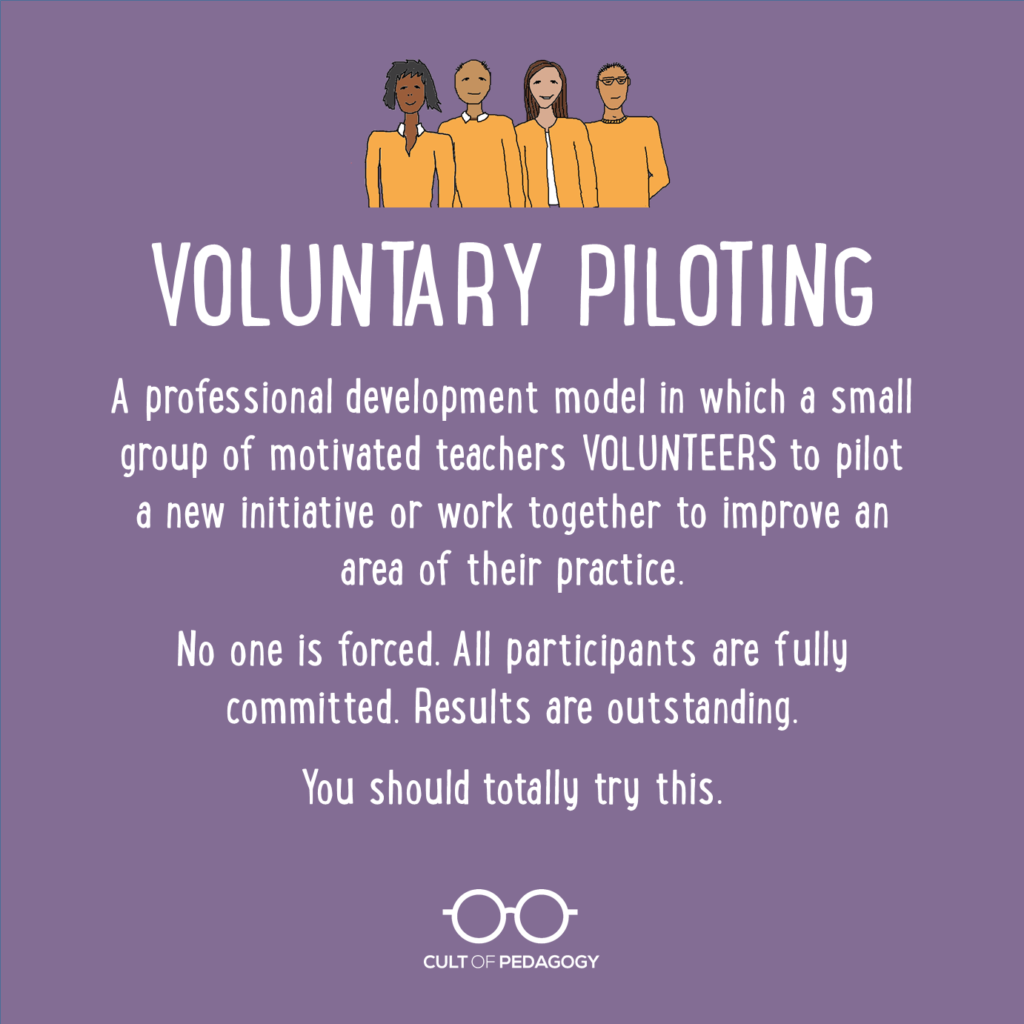
Why Voluntary Piloting Worked for Us
What I know for sure is that because of the commitment I made by joining this group, I pushed myself harder. When we began, differentiation was something that only happened sometimes in my classroom, and, as a result, it was somewhat uncomfortable for my students. Today, the vast majority of assignments are differentiated, and students expect this and discuss it openly.
This shift took three years, and it wasn’t just my classroom that was profoundly impacted by the work of our pilot group. Each of the participants experienced significant changes in practice, and throughout the course of the past three years, we have continued to review the research, implement shifts, examine our own data, and repeat this cycle again and again.
Have we found all the answers? No, not yet. We probably never will. But that’s not really the point. Our work with differentiation has grown so much. Those of us in that original pilot group have achieved our original vision of classrooms where differentiation has become a norm. We now, of course, have bigger hopes and dreams for ourselves. Meanwhile, other members of our faculty have followed our lead, and differentiation strategies are being implemented at different levels throughout our building.
But more importantly, through our research and discussions, we are challenging each other and improving our practice. And, more than that, we are supporting each other and helping each other hold fast to the dream of inspiring our students and guiding them to develop into well-rounded and educated adults.
Implementing Voluntary Piloting in Your School
You can begin building this spirit of professional collaboration and growth in your building, too. Our group was dedicated to increasing differentiation practices, but any professional issue could serve as your focus.
Here are what we’ve found to be the necessary components to making a program like this effective:
- Grab the bull by the horns: Whatever is the greatest challenge or frustration in your building or classroom, tackle that.
- Make it purely voluntary; there is no room for naysayers. Some people may need a personal invitation, but no begging. The people who decline your invitation are not ready to be part of the first wave.
- Develop your objectives and procedures together. Focus on what you want from each other. What are your shared goals? How can you best support each other in achieving them? What limits and boundaries do people need to have respected?
- Hold structured meetings as a way to honor everyone’s time and energy. Avoid allowing this group to become a de facto lunch break or happy hour. Value the work to be done.
- Identify a meeting facilitator who takes responsibility for convening the meetings and moving through the agenda. This can be a single person or a rotating role.
- Resist the temptation to spend time complaining. It is important for the meeting facilitator to lead the group toward the generation of solutions, and away from the slippery slope of negativity.
- Brainstorm together—there’s no reason people should be working on the same things in isolation. Do it together, and you’ll be more successful and more energized.
- Don’t just brainstorm. Implement. Even if that means taking one baby step at a time. And pick each other up when you fall. Because sometimes the ideas that sounded so great in theory weren’t so great in reality. It’s easy to get discouraged, so be cheerleaders for each other.
- Hold each other accountable for implementation. But remember, the goal is progress, not perfection. We used our Friendly Feedback Observations for this.
- Keep going. As you move forward, others will witness your success, and your influence will spread.
While traditional PD is likely to continue, you need not allow it to dictate your professional growth. Think about what you want to work on in your classroom. Seek out like-minded educators in your building, and set aside time to work on this together. Dig deep. Find strategies that are feasible. Try them out. Reflect on what worked and what didn’t. And repeat this process.
This work leads to powerful, uplifting, and beneficial professional growth. All you have to do is decide what you want to work on, find others who want to work on that, too, and get started. ♦
Join my mailing list and get weekly tips, tools, and inspiration—in quick, bite-sized packages—all geared toward making your teaching more effective and fun. You’ll also get access to my members-only library of free downloadable resources, including my e-booklet, 20 Ways to Cut Your Grading Time in Half, which has helped thousands of teachers spend less time grading!

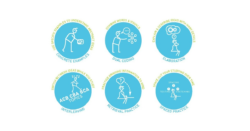


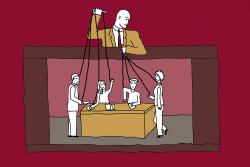
This idea is great. Thank you for always providing new options for teachers to keep learning.
Love this post! I’m a building liiteracy coach. I facilitated a group like this last year around how teachers were designing core literacy instruction in our high poverty school. The group evolved organically from a group of teachers who had the same questions about instructional design. All the teachers felt the meeting discussions and shared ideas were helpful. Teachers earned clock hours for participation. Trust and rapport increased among participants. I sent out meeting notes/ideas shared to the whole staff so others who couldn’t be there could also benefit.
Fantastic Idea! I really liked the voluntary component and admonishment to respect time and focus on implementation versus complaining! I will definitively be sharing this article!
I’ve used this model in a school with similar students – it worked so well. We differentiated the 6 tables into ability spaces and students made their way around the room according to where they were at and eventually to where they wanted to be after a period of time. The Year 7 students labelled the ability tables by colour and took ownership of their learning – something they were never trusted with before. When the assistant principal questioned their final grades at the end of the year, we showed her the evidence of differentiation with a variety of work samples and video footage we collected over the year. Each of us in the pilot group had the same vision and used the same methods so consistency was key in moving these students to places they had never experienced. Thoroughly recommend it if you have the right people on board!
I love this post. I’d also love to hear more specifics about what you discovered and implemented as a result of your work on differentiation.
Thank you so much for telling your story! I cannot wait to share this with my admin. I am a gifted teacher/differentiation coach and one of our focuses this year is differentation. This article gave me so many ideas for implementation in my own school. Thanks again!
Thank you, Krista, for this post. I have long been a proponent of teachers selecting their own PD path. However, what I like about voluntary piloting is that someone takes the initiative to invite other teachers to become part of a professional community that is truly interested in learning and growing its knowledge base and practice. This spills over eventually; I’ve seen it happen before.
Regards,
Elisa
I’m fascinated with the voluntary piloting program you and your colleague embarked upon and was curious if you are open to sharing any materials and/or feedback you have from this?
After teaching in CPS for three years at Winton Montessori (before it moved to Northside/became Parker Woods), I moved to San Diego, taught in a Montessori charter here and have now moved into an administrative role at another public Montessori charter. I’m looking for innovative and effective ways to afford Montessori educators autonomy in, at least, the professional development realm. Your work seems to be just the right fit.
Hi Candace,
What a small world it is! I’m more than happy to share materials; although I’m not quite sure what it is you’re looking for. For me, the most critical component was that this pilot was teacher-driven and led, collaborative, and voluntary. We repeated this in a subsequent year, where there was a choice of four topics, but the sessions were held during scheduled PD time, and were thus mandatory for all staff. I expected people to really be on board — it was time that was required of them anyway, they got to select their focus topic from the four options, and those options had been determined through a staff survey. However, in all honesty, it was not nearly as effective and supportive as the purely voluntary program was.
Feel free to shoot me an email at taylorkrista70@gmail.com with more specifics, and I’ll happily share whatever I have.
Also, check out the blog I write with my principal AngelsAndSuperheroes.com — there are many helpful posts there written with a Montessori spirit and embedded in research-based, best practices. We link lots of resources within the posts that are available for free download. I think you’ll find a lot of useful topics in the archives for yourself and your staff. And if you subscribe you’ll get all of our new posts sent directly to your inbox.
I’m jealous of your current location as I attended the AMS conference in San Diego last spring and came away wondering why on earth anyone bothered to live anywhere else!
I really enjoyed this blog! I always encourage schools to start with the coalition of the willing. This blog will be great to share with leaders and instructional coaches. Thank you!